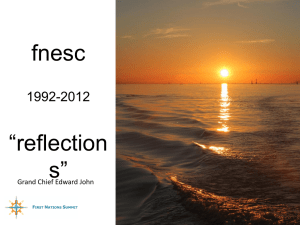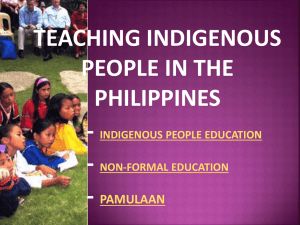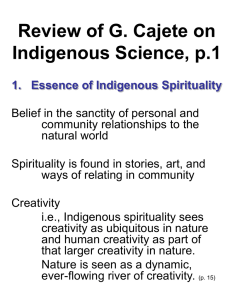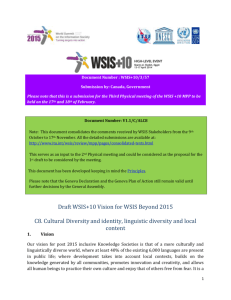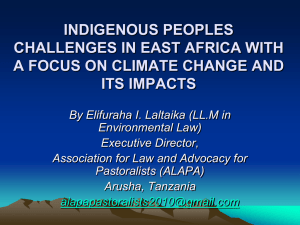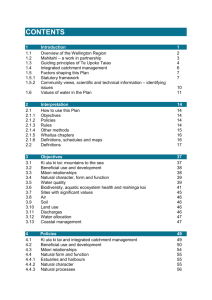Week 3: Land, Heritage and Identity: A Holistic View
advertisement
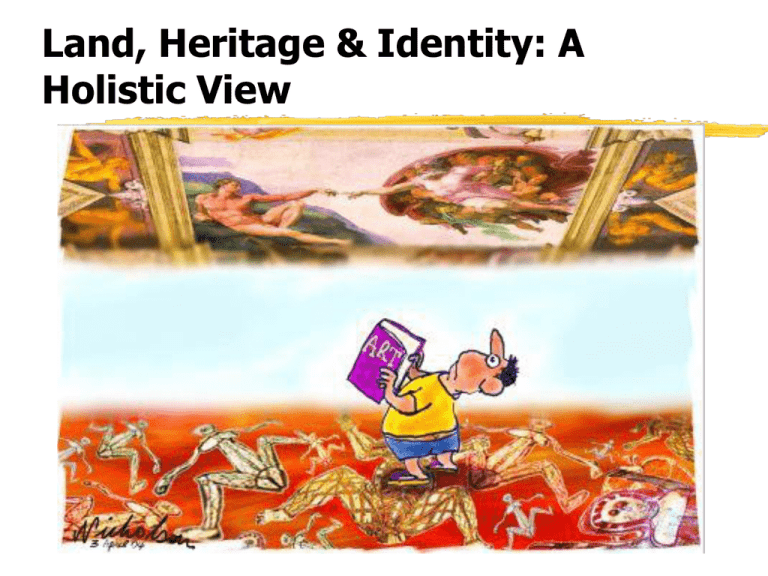
Land, Heritage & Identity: A Holistic View Lecture Format Relationship between land, heritage & identity Holistic view of land & heritage Framework for analysing Indigenous rights Key factors that need to be considered in understanding Indigenous land relations An awarness of the extent to which imported constructs have been used to catagorise, classify and to create stereotypical notions of Indigneous identity and culture. Aboriginal culture in its proper time perspective-past & present as one holistic continum The concept of change adaption & continuity - an evolving process familiar to any cultural system The existence of an ongoing-living culture that continues to survive and maintain its connections with the ancestral lands (Beattie,J. Other Cultures: Aims, Methods & Achievements, 1964:241-264). Nature of Relationship between Land Culture & Identity-Indigenous Voices Mick Dodson describes the relationship between land culture and identity, as one, the heart of which ‘is deeply rooted in our traditions, our knowledges, and the lands which we have inherited from our ancestors’. Take away land, and you take away our soul and identity as a people’ (Dodson, M. 1994: 7). Holistic connections with the Land Everything about Aboriginal society is inextricably interwoven and connected to the land. Culture is the land…our reason ofr existence is the land. You take that away and you take away our reason for existence. We have grown the land up. We are dancing,singing,painting for the land. We are celebrating the land. Removed from the land we are literally removed from ourselves (Mick Dodson, 2000) Understanding Indigenous culture Many non-Indigenous people have attempted to bridge the gap of crosscultural understanding. In his portrait of the Dreaming, Professor Stanner argues that a greater appreciation can be achieved by unlocking ourselves from western categories of understanding and viewing Indigenous culture and land relations from the Indigenous perspective Learning how to ‘think black’ is way to more complete undertanding (Stanner, 1987:225). Frans Hoogland ‘We [non-Indigenous people] don’t see the connections of all things. We put all the birds into a box-they are birds. We put all the rocks in a box — they are rocks. But they are one and we are a part of it. We all make up the living country’ (Hoogland, 1999:11- 21). The Holistic Approach to Understanding Indigenous Culture The holistic approach to understanding natural and cultural values is one of the trademarks of David Attenborough's work. He creates his sense of story by focusing on the relationship between things: between animal and plants, between humans and the earth. It is this sense of the way everything relates, and Attenborough’s ability to create a sense of poetry out of the natural world that makes his nature documentaries so special ( The Age, 29 March 2003:22). Fences & Site Protection-Barmah Forest Framework for Analysing Land and Heritage Rights Framework drawn from human rights principles of racial equality and justice before the law,which will be used to: Critically assess the way that common law notions of property rights have been applied in relation to Indigenous land and heritage rights and to Identify the barriers to land justice following the historic Mabo decision. Key Rights Being Asserted right to land & resources right to practice, revitalise and transmit culture Right to control & ownership of cultural property International Instruments Convention for the Elimination of Racial Discrimination (CERD) which will be used to assess the degree of equality that Indigenous Australians enjoy in the ownership and control of their land and heritage International Convention on Civil and Political Rights, which affirms the principle of self determination and the right of peoples to have control over their social, economic and cultural affairs Working Group on Indigenous Peoples (WGIP) The United Nations' Draft Declaration on the Rights of Indigenous Peoples (1997) (Article 12) which affirms the right of Indigenous peoples to have control of their cultural traditions and customs and to have their cultural property returned to them. Article 29 states that: Indigenous people are entitled to the recognition of full ownership, control and protection of their cultural and intellectual property. Indigenous Rights Draft Declaration on The Human Rights of Indigenous Peoples,1993 Produced by members of the Indigenous Working Group, UN Commission on Human Rights (http://webraft.its.unimelb.edu.au/166038/pub/readingmaterials.htm)


